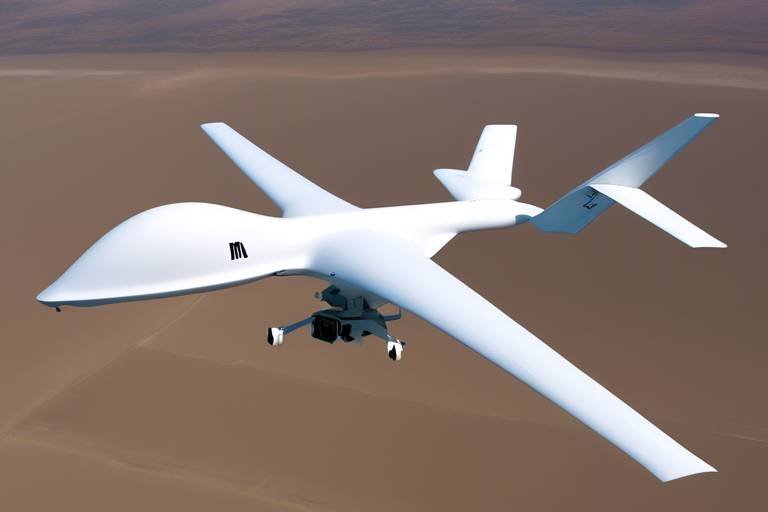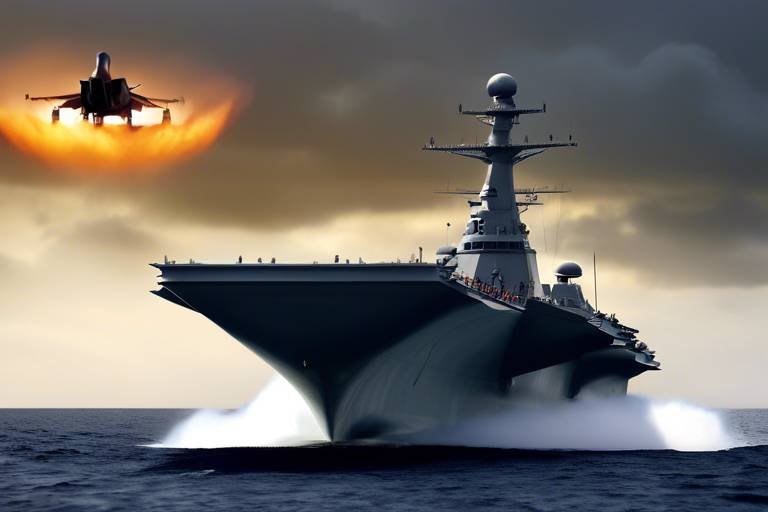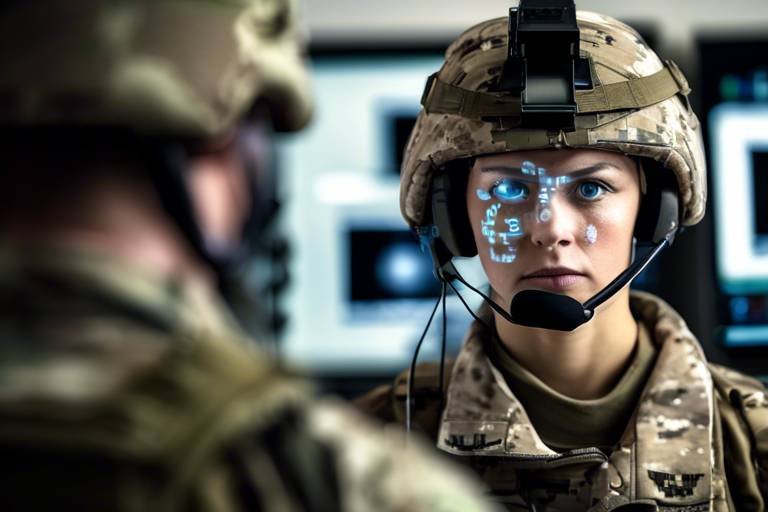The Impact of New Technologies on Defense Logistics
In today's fast-paced world, the military is not just about strategy and strength; it's also about innovation and adaptability. The defense sector is undergoing a remarkable transformation driven by emerging technologies that are reshaping logistics operations. Imagine a scenario where supplies are delivered seamlessly, decisions are made with pinpoint accuracy, and every asset is tracked with unerring precision. This is not a distant dream; it’s becoming a reality thanks to advancements in technology.
As we delve into the intricacies of defense logistics, it’s essential to understand how these innovations are enhancing efficiency and addressing longstanding challenges. From automation and artificial intelligence to blockchain and the Internet of Things (IoT), each technological advancement brings with it a wave of possibilities that can redefine military supply chains. Think of these technologies as the modern-day equivalents of the supply routes that once sustained armies, but now they operate with a level of sophistication that was unimaginable just a few years ago.
Moreover, the integration of these technologies is not merely about keeping pace with change; it’s about staying ahead of potential threats and ensuring that military operations can be executed flawlessly. As we explore the multifaceted impact of these technologies, we will uncover how they are not only improving operational efficiency but also enhancing accountability, transparency, and sustainability within defense logistics.
In the sections that follow, we will examine various aspects of this technological revolution, including the role of automation in streamlining supply chain management, the transformative power of artificial intelligence and predictive analytics, and how blockchain technology is paving the way for greater transparency. We'll also look at the significance of IoT in logistics, the revolutionary potential of 3D printing, the pressing need for cybersecurity measures, and the importance of sustainability in military operations.
So, buckle up as we embark on this journey through the evolving landscape of defense logistics, exploring the challenges, benefits, and future trends that these new technologies are ushering in. The future of military supply chains is not just about efficiency; it’s about creating a resilient, responsive, and responsible defense apparatus that can meet the demands of modern warfare.
- What are the main technologies impacting defense logistics?
Key technologies include automation, artificial intelligence, blockchain, the Internet of Things (IoT), and 3D printing, each contributing to enhanced efficiency and responsiveness.
- How does automation improve supply chain management?
Automation streamlines processes, reduces human error, and increases operational efficiency, allowing for faster and more accurate logistics operations.
- What role does cybersecurity play in defense logistics?
As technology advances, protecting sensitive information and systems from cyber threats becomes critical to maintaining operational integrity.
- Why is sustainability important in defense logistics?
Sustainability practices help reduce environmental impact and enhance operational efficiency, aligning military operations with global ecological goals.

Automation in Supply Chain Management
Automation is not just a buzzword; it's a game changer in the realm of defense logistics. Imagine a world where supply chains operate seamlessly, where human error is minimized, and efficiency is maximized. That's the promise of automation! By integrating automated systems into supply chain management, military organizations can streamline processes, making them faster and more reliable. But what does this really mean for the men and women in uniform? Well, for starters, it means fewer delays in getting vital supplies to the front lines.
One of the most significant benefits of automation is its ability to reduce human error. In high-stakes environments like defense logistics, even a small mistake can have serious consequences. Automated systems can handle repetitive tasks—such as inventory tracking and order processing—much more accurately than humans. This not only speeds up operations but also ensures that the right supplies are available when they are needed most.
However, implementing automation isn't without its challenges. Organizations must invest in new technologies and training for their personnel. This transition period can be daunting, but the long-term benefits often outweigh the initial hurdles. For instance, consider the following advantages of automation in defense logistics:
- Increased Efficiency: Automated systems can process orders and manage inventory much faster than manual methods.
- Cost Savings: While the upfront investment may be high, automation can lead to significant savings over time by reducing labor costs and minimizing waste.
- Enhanced Data Accuracy: Automation reduces the likelihood of human error, leading to more accurate data and better decision-making.
Moreover, automation technologies such as robotics and machine learning are beginning to revolutionize how logistics operations are conducted. For example, autonomous vehicles can transport supplies without human intervention, allowing personnel to focus on more strategic tasks. Similarly, machine learning algorithms can analyze vast amounts of data to predict supply chain disruptions before they occur, enabling proactive measures to be taken.
As we look toward the future, the integration of automation in defense logistics will likely continue to evolve, driven by advancements in technology. The potential for increased responsiveness and the ability to adapt quickly to changing circumstances make automation an essential component of modern military operations. With ongoing developments, we can expect to see even more sophisticated automated systems that will further enhance the efficiency and effectiveness of defense logistics.
In conclusion, while the road to full automation may present challenges, the payoff is undeniably worth it. By embracing these technologies, defense logistics can not only improve operational efficiency but also ensure that our military personnel are always equipped with the resources they need to succeed. The future is bright for automated supply chain management!

Artificial Intelligence and Predictive Analytics
Artificial Intelligence (AI) and predictive analytics are not just buzzwords; they are game-changers in the realm of defense logistics. Imagine a world where military supply chains operate with the precision of a well-oiled machine, anticipating needs before they arise. That’s the power of AI and predictive analytics! By leveraging vast amounts of data, these technologies allow military logistics professionals to make informed decisions that enhance efficiency and reduce costs.
One of the primary benefits of AI in defense logistics is its ability to analyze historical data and identify patterns that humans might overlook. For instance, AI systems can process data from previous military operations to forecast future requirements. This means that instead of waiting for supplies to run low, military planners can proactively manage inventory levels. This not only ensures that troops have what they need when they need it, but it also minimizes waste, which is crucial in maintaining budgetary constraints.
Predictive analytics takes this a step further by utilizing algorithms to predict potential supply chain disruptions. By analyzing factors such as weather patterns, geopolitical events, and historical data, these systems can alert logistics personnel to possible challenges before they become critical issues. For example, if a natural disaster is forecasted to impact a key supply route, predictive analytics can suggest alternative routes or preemptively stockpile essential supplies to mitigate risks. This capability is akin to having a crystal ball that helps military leaders stay one step ahead.
However, the integration of AI and predictive analytics is not without its challenges. Data quality is paramount; if the data fed into these systems is flawed or outdated, the predictions will be equally unreliable. Additionally, there’s the issue of training personnel to work alongside these advanced technologies. To truly harness the potential of AI, military logistics teams must be well-versed in data interpretation and technology management.
Moreover, the implementation of AI in defense logistics raises important questions about security and ethics. With sensitive data being processed, ensuring robust cybersecurity measures is essential to protect against potential breaches. Furthermore, as AI systems become more autonomous, ethical considerations regarding decision-making in military operations must be addressed. Who is accountable if an AI-driven decision leads to unintended consequences?
In summary, the integration of artificial intelligence and predictive analytics in defense logistics holds immense potential to transform military operations. By enhancing forecasting capabilities, improving inventory management, and enabling proactive decision-making, these technologies can significantly improve the efficiency and effectiveness of military supply chains. However, as with any technological advancement, careful consideration must be given to data quality, cybersecurity, and ethical implications to ensure that the benefits are fully realized without compromising security or accountability.
- How does AI improve decision-making in defense logistics?
AI analyzes vast amounts of data to identify patterns and forecast future needs, allowing for informed decision-making. - What are the challenges of implementing predictive analytics?
Challenges include ensuring data quality, training personnel, and addressing security concerns. - Can AI systems operate autonomously in military logistics?
While AI can automate certain processes, human oversight is crucial for ethical and accountability reasons.

Blockchain for Enhanced Transparency
In an era where information is paramount, blockchain technology emerges as a beacon of hope for enhancing transparency in defense logistics. Imagine a world where every movement of supplies, from the moment they leave the warehouse to their final destination on the battlefield, is recorded on an immutable ledger. This is the promise of blockchain—providing a secure and transparent way to track assets and transactions.
The core principle of blockchain is its decentralized nature, which means that no single entity has control over the entire network. This is particularly beneficial in the military context, where accountability and trust are essential. By utilizing blockchain, defense organizations can create a transparent supply chain that minimizes the risk of fraud and mismanagement. Each transaction is recorded in a block, and once added to the chain, it cannot be altered or deleted. This level of security ensures that all stakeholders have access to the same information, fostering a culture of trust.
Moreover, blockchain can significantly enhance the accountability of suppliers and contractors. For instance, if a particular component is found to be defective, blockchain allows for a quick trace back through the supply chain to identify where the breakdown occurred. This capability not only helps in rectifying issues swiftly but also in holding the responsible parties accountable. It’s like having a digital fingerprint for every item in the supply chain, ensuring that nothing goes unnoticed.
Furthermore, the integration of blockchain technology can streamline the procurement process. By automating contract execution through smart contracts—self-executing contracts with the terms of the agreement directly written into code—organizations can reduce the time and resources spent on paperwork. This not only speeds up the procurement process but also minimizes human error, which can often lead to costly delays and miscommunications.
However, the implementation of blockchain is not without its challenges. The initial setup can be complex, requiring significant investment in technology and training. Additionally, there is a need for standardization across various military branches and agencies to ensure interoperability. Despite these hurdles, the long-term benefits of enhanced transparency and security make blockchain an attractive solution for modern defense logistics.
In conclusion, as defense logistics continue to evolve, the adoption of blockchain technology will play a crucial role in addressing the challenges of transparency and accountability. By harnessing this innovative technology, military organizations can create a more efficient and trustworthy supply chain, ultimately leading to improved operational readiness and effectiveness.
- What is blockchain technology?
Blockchain technology is a decentralized digital ledger that records transactions across many computers in such a way that the registered transactions cannot be altered retroactively. - How does blockchain enhance transparency in defense logistics?
Blockchain enhances transparency by providing an immutable record of transactions, allowing all stakeholders to access the same information and track assets in real-time. - What are smart contracts?
Smart contracts are self-executing contracts with the terms of the agreement directly written into code, which can automate processes and reduce the need for intermediaries. - What challenges does blockchain face in defense logistics?
The main challenges include the complexity of implementation, the need for standardization, and the initial investment required for technology and training.

Internet of Things (IoT) in Logistics
The Internet of Things (IoT) is not just a buzzword; it's a game-changer in the world of defense logistics. Imagine a network of devices, sensors, and systems all communicating in real-time, providing an unprecedented level of visibility and control over military supply chains. With IoT, logistics operations are becoming smarter, faster, and more efficient, fundamentally altering how the military manages its resources.
One of the most significant advantages of IoT in logistics is real-time tracking. Traditional supply chain methods often lag in providing up-to-date information, leading to delays and inefficiencies. However, with IoT-enabled devices, military personnel can monitor the location and condition of supplies and equipment instantaneously. This capability ensures that decision-makers have the most current data at their fingertips, allowing them to respond swiftly to any changes or disruptions. For instance, if a shipment is delayed, logistics managers can reroute resources or adjust schedules to mitigate the impact.
Furthermore, IoT enhances monitoring and communication across various stages of the supply chain. Sensors can track temperature, humidity, and other environmental factors that could affect sensitive materials. This monitoring is crucial for maintaining the integrity of supplies, especially in defense operations where the stakes are high. By employing IoT technology, military logistics can ensure that critical supplies are not only delivered on time but also in optimal condition.
Another exciting application of IoT is in predictive maintenance. By collecting data from equipment and vehicles, IoT devices can analyze performance and predict when maintenance is needed. This proactive approach reduces downtime and extends the lifespan of assets. Imagine a scenario where a military vehicle is scheduled for deployment, and IoT sensors detect a potential mechanical issue. Instead of waiting for a failure to occur, maintenance can be performed before it becomes a problem, ensuring operational readiness.
Despite its numerous benefits, the implementation of IoT in defense logistics does come with challenges. One of the primary concerns is cybersecurity. With so many devices connected to the internet, the risk of cyberattacks increases. Sensitive military data could be compromised if proper security measures are not in place. Therefore, it is essential for defense organizations to invest in robust cybersecurity protocols to protect their IoT infrastructure.
In conclusion, the Internet of Things is revolutionizing defense logistics by providing enhanced visibility, improving communication, and enabling predictive maintenance. As military operations become more complex and dynamic, the adoption of IoT technologies will be critical for maintaining efficiency and effectiveness in supply chain management. The future of defense logistics is undoubtedly intertwined with the advancements in IoT, paving the way for smarter and more resilient military operations.
- What is IoT in logistics? IoT in logistics refers to the use of interconnected devices and sensors that communicate in real-time to improve supply chain management and operational efficiency.
- How does IoT improve supply chain visibility? IoT devices provide real-time data on the location and condition of supplies, allowing for immediate adjustments and improved decision-making.
- What are the cybersecurity risks associated with IoT? The interconnected nature of IoT devices increases the risk of cyberattacks, making it essential to implement strong security measures to protect sensitive data.

3D Printing and On-Demand Manufacturing
In the world of defense logistics, 3D printing is not just a trend; it's a game changer. Imagine being able to produce critical components on-demand, right at the point of need. This technology has the potential to drastically reduce lead times and logistical challenges, ensuring that military operations can proceed without the usual delays associated with traditional manufacturing methods. By leveraging additive manufacturing, the military can create spare parts, tools, and even entire systems with remarkable speed and precision.
One of the most significant advantages of 3D printing is its ability to produce complex geometries that are often impossible to achieve through conventional manufacturing techniques. This means that components can be designed with enhanced functionality, resulting in improved performance and reliability. For example, lightweight structures can be created that maintain strength while reducing the overall weight of equipment, which is crucial in military applications where every ounce counts.
Moreover, the ability to print parts on-demand means that military units can operate in remote locations without the need for extensive supply chains. Instead of waiting weeks for a shipment of parts, soldiers can simply print what they need, when they need it. This capability not only enhances operational efficiency but also reduces the logistical footprint of military operations. The implications for inventory management are profound; instead of maintaining large stockpiles of spare parts, units can adopt a just-in-time approach, producing items as required.
However, the integration of 3D printing into defense logistics does come with its challenges. Ensuring the quality and reliability of printed parts is paramount, as any failure could have serious consequences on the battlefield. To address this, rigorous testing and certification processes must be established. Additionally, there are concerns regarding the intellectual property of designs and the potential for unauthorized reproduction of sensitive components. Therefore, robust security measures must be put in place to protect designs and maintain the integrity of military assets.
As we look to the future, the potential applications of 3D printing in defense logistics continue to expand. From manufacturing custom tools tailored to specific missions to creating lightweight drone components, the possibilities are virtually limitless. The technology is not just about efficiency; it’s about innovation and rethinking how we approach military logistics. In a rapidly changing world, embracing 3D printing could very well be the key to maintaining a competitive edge in defense operations.
In conclusion, represent a significant leap forward for defense logistics. While there are hurdles to overcome, the benefits of reduced lead times, enhanced customization, and lowered logistical burdens make it an essential focus for military planners and logisticians alike. As this technology continues to evolve, it promises to reshape the landscape of defense logistics, making operations more agile and responsive than ever before.
- What is 3D printing in defense logistics?
3D printing, or additive manufacturing, is a process that creates three-dimensional objects from digital files, allowing for the on-demand production of parts and tools. - How does 3D printing improve operational efficiency?
By enabling the production of parts at the point of need, 3D printing reduces lead times and the reliance on traditional supply chains. - What challenges does 3D printing face in the military?
Challenges include ensuring the quality and reliability of printed parts, protecting intellectual property, and establishing security measures for sensitive designs. - What are the future applications of 3D printing in defense?
Future applications may include custom tool manufacturing, lightweight component production for drones, and rapid prototyping for new technologies.

Cybersecurity Challenges in Defense Logistics
In today's rapidly evolving digital landscape, cybersecurity has emerged as a critical concern in defense logistics. With the increasing reliance on technology for managing military supply chains, the potential for cyber threats has grown exponentially. Imagine a scenario where sensitive military data is intercepted by adversaries, or supply chain operations are disrupted by a cyber attack. The implications could be catastrophic, jeopardizing national security and operational effectiveness.
One of the primary challenges in ensuring cybersecurity within defense logistics is the complexity of supply chain networks. These networks often involve multiple stakeholders, including suppliers, manufacturers, and logistics providers, each with their own systems and protocols. This interconnectedness creates numerous entry points for potential cyber attacks. As such, maintaining robust cybersecurity measures across all levels of the supply chain is not just advisable; it's essential.
Moreover, the increasing use of Internet of Things (IoT) devices in logistics further complicates the cybersecurity landscape. While IoT devices enhance real-time tracking and monitoring, they also introduce vulnerabilities. For instance, if an IoT sensor on a military vehicle is compromised, it could lead to unauthorized access to sensitive information or even the vehicle itself. This highlights the need for stringent security protocols that encompass both traditional IT infrastructure and emerging IoT technologies.
Another pressing issue is the human factor. Employees often represent the weakest link in the cybersecurity chain. Whether through phishing attacks or unintentional errors, human actions can inadvertently expose critical systems to cyber threats. Therefore, it is vital for defense logistics organizations to invest in comprehensive training programs that educate personnel on cybersecurity best practices. Regular drills and awareness campaigns can significantly reduce the likelihood of human error leading to security breaches.
To tackle these challenges, organizations must adopt a multi-layered approach to cybersecurity. This could involve:
- Risk Assessment: Regularly evaluating the vulnerabilities within the supply chain and implementing measures to mitigate identified risks.
- Access Controls: Establishing strict access controls to limit who can view or manipulate sensitive data.
- Incident Response Plans: Developing and regularly updating incident response plans to ensure swift action in the event of a cyber attack.
In conclusion, as defense logistics continues to embrace new technologies, the importance of cybersecurity cannot be overstated. It is a continuous battle against evolving threats, requiring vigilance, adaptability, and a commitment to safeguarding sensitive information. By prioritizing cybersecurity, defense logistics can not only protect its operations but also enhance overall efficiency and effectiveness in fulfilling its mission.
1. What are the main cybersecurity threats facing defense logistics?
Defense logistics faces various threats, including phishing attacks, ransomware, insider threats, and vulnerabilities in IoT devices.
2. How can organizations improve their cybersecurity posture?
Organizations can improve their cybersecurity by conducting regular risk assessments, implementing access controls, training employees, and developing incident response plans.
3. Why is the human factor significant in cybersecurity?
The human factor is significant because employees can inadvertently expose systems to cyber threats through actions like falling for phishing scams or mishandling sensitive data.
4. What role does IoT play in defense logistics cybersecurity?
While IoT enhances tracking and monitoring, it also introduces vulnerabilities that can be exploited by cyber attackers, necessitating robust security measures.

Sustainability and Green Technologies
The conversation around sustainability is gaining momentum in every sector, and defense logistics is no exception. As military operations evolve, the need to integrate green technologies into logistics becomes increasingly critical. Not only does this shift help in reducing the environmental impact, but it also enhances operational efficiency, making it a win-win situation. Imagine a world where military supply chains operate with the same eco-conscious mindset as a local organic farm; that’s the future we’re heading towards!
One of the most significant aspects of incorporating sustainability into defense logistics is the reduction of carbon footprints. By utilizing renewable energy sources, such as solar and wind power, military bases and supply depots can significantly decrease their reliance on fossil fuels. This transition is not just a trend; it's a necessity for preserving our planet for future generations. Additionally, many defense organizations are investing in electric vehicles and hybrid technologies, which not only cut down on emissions but also save money on fuel in the long run.
Furthermore, green supply chain management practices are being adopted to minimize waste and maximize resource efficiency. This includes everything from recycling materials to optimizing transportation routes to reduce fuel consumption. For instance, using advanced software to plan supply routes can lead to significant cost savings and lower emissions, much like how a smart navigation app helps you avoid traffic jams on your daily commute.
In addition to these practices, the use of sustainable materials in manufacturing processes is becoming a priority. Defense contractors are increasingly looking to source materials that are not only durable but also environmentally friendly. This includes using recycled metals and biodegradable composites in the production of military equipment. By opting for sustainable materials, the defense sector can significantly reduce its environmental impact while still maintaining the high standards required for military operations.
Moreover, the integration of circular economy principles into defense logistics is a game-changer. This approach emphasizes the importance of reusing and recycling products at the end of their life cycle. For example, instead of discarding old equipment, the military can refurbish and repurpose it, thereby saving money and reducing waste. This practice not only conserves resources but also fosters innovation in how we think about military logistics.
As we look towards the future, it’s clear that sustainability and green technologies will play a pivotal role in shaping defense logistics. The military's commitment to these practices not only addresses environmental concerns but also enhances operational effectiveness. The challenge lies in balancing the need for advanced military capabilities with the responsibility to protect our planet. However, with ongoing advancements in technology and a growing awareness of environmental issues, the defense sector is well-positioned to lead the way in sustainable practices.
In summary, the integration of sustainability in defense logistics is not merely an option; it is becoming a fundamental requirement. By embracing green technologies and sustainable practices, the military can ensure that it remains effective while also being a responsible steward of the environment. The journey towards sustainability is ongoing, but the strides being made today are paving the way for a greener, more efficient future.
- What are green technologies in defense logistics? Green technologies refer to innovations that reduce environmental impact, such as renewable energy sources, electric vehicles, and sustainable materials.
- Why is sustainability important in defense logistics? Sustainability is crucial as it helps minimize the environmental footprint of military operations while enhancing operational efficiency and cost-effectiveness.
- How can the military reduce its carbon footprint? The military can reduce its carbon footprint by utilizing renewable energy, optimizing supply routes, and investing in electric and hybrid vehicles.
- What is a circular economy in defense logistics? A circular economy focuses on reusing and recycling materials and equipment, thereby minimizing waste and conserving resources.

Training and Workforce Development
In the rapidly evolving landscape of defense logistics, the integration of new technologies presents both exciting opportunities and daunting challenges. As the military embraces innovations like automation, artificial intelligence, and the Internet of Things, it becomes increasingly clear that are critical to harnessing these advancements effectively. Without a well-prepared workforce, even the most sophisticated technologies can fall short of their potential.
Imagine a world where soldiers can access real-time data about their supply chains, ensuring that they have the right materials at the right time. This vision can only become a reality if personnel are equipped with the necessary skills to operate and manage these technologies. The question then arises: how do we ensure that our workforce is ready for this technological revolution?
One of the key strategies for effective training is the implementation of ongoing education programs. These programs should not only focus on the technical skills required to operate new systems but also on fostering a culture of adaptability and continuous learning. This is especially important given the pace at which technology evolves. By providing opportunities for upskilling, organizations can create a workforce that is not just reactive, but proactive in embracing change.
Moreover, hands-on training is essential. Simulations and practical exercises can offer invaluable experience, allowing personnel to engage with new technologies in a controlled environment. For instance, a training program could include:
- Workshops on using AI for predictive analytics in supply chain management.
- Simulation exercises that incorporate IoT devices for real-time tracking.
- 3D printing labs where personnel can learn to create spare parts on demand.
In addition to technical training, soft skills such as communication, teamwork, and problem-solving are equally important. As defense logistics becomes more interconnected, the ability to collaborate across different teams and adapt to changing circumstances will be crucial. To address this, organizations should incorporate team-building exercises and cross-functional training into their development programs.
Another vital aspect of training and workforce development is the role of leadership. Leaders must champion the adoption of new technologies and foster an environment where learning is encouraged. This can be achieved by:
- Promoting a culture of innovation.
- Encouraging feedback from personnel on training needs and technological challenges.
- Investing in leadership training that emphasizes the importance of technology in logistics.
Furthermore, partnerships with educational institutions and technology providers can enhance training initiatives. Collaborating with universities and tech companies can provide access to cutting-edge research and training resources, ensuring that military personnel are at the forefront of technological advancements.
In summary, as defense logistics continues to evolve with new technologies, the importance of training and workforce development cannot be overstated. By investing in ongoing education, hands-on training, leadership development, and strategic partnerships, we can prepare our workforce to meet the challenges of tomorrow. The future of defense logistics depends not only on technology but also on the people who will wield it effectively.
Q1: Why is training important in defense logistics?
A1: Training is crucial because it ensures that personnel are equipped with the skills necessary to operate new technologies effectively, enhancing overall efficiency and responsiveness in military supply chains.
Q2: What types of training should be prioritized?
A2: Both technical training on new technologies and soft skills such as communication and teamwork should be prioritized to foster a well-rounded and adaptable workforce.
Q3: How can organizations ensure ongoing learning?
A3: Organizations can implement continuous education programs, hands-on training sessions, and encourage a culture of adaptability to ensure that personnel are always up-to-date with the latest advancements.

Future Trends in Defense Logistics Technology
The landscape of defense logistics is evolving at a breathtaking pace, driven by innovations that promise to redefine how military operations are conducted. As we look to the future, several key trends are emerging that will undoubtedly shape the way defense logistics functions. From the integration of advanced technologies to the adoption of new operational strategies, these trends are set to enhance efficiency, responsiveness, and effectiveness in military supply chains.
One of the most significant trends is the increasing reliance on artificial intelligence (AI) and machine learning. These technologies are not just buzzwords; they are becoming integral to logistics planning and execution. AI algorithms can analyze vast amounts of data to predict supply needs, optimize routes, and even manage inventory levels in real-time. Imagine a scenario where a military unit receives supplies precisely when and where they are needed, minimizing waste and maximizing operational readiness. This level of precision is no longer a dream; it's on the horizon.
Another trend that cannot be overlooked is the rise of autonomous systems. Drones and autonomous vehicles are becoming commonplace in logistics operations. These systems can transport supplies to remote locations without the need for human intervention, reducing risk and increasing efficiency. For instance, a drone could deliver critical medical supplies to a forward operating base in a matter of minutes, a feat that would take hours using traditional methods. The implications for speed and safety are enormous.
Moreover, the concept of digital twins is gaining traction in defense logistics. A digital twin is a virtual representation of a physical asset or system that can be used for simulation and analysis. By creating digital twins of supply chains, military planners can run simulations to identify potential bottlenecks, optimize resource allocation, and improve overall performance. This proactive approach allows for better decision-making and more resilient logistics operations.
In addition to these technological advancements, there is a growing emphasis on sustainability. The military is increasingly recognizing the importance of minimizing its environmental footprint. Future logistics operations are likely to incorporate green technologies, such as electric vehicles and renewable energy sources, to reduce emissions and reliance on fossil fuels. This shift not only benefits the planet but also enhances operational efficiency and public perception.
Lastly, as technology becomes more integrated into defense logistics, the need for robust cybersecurity measures will be paramount. With the rise of IoT devices and interconnected systems, the military must safeguard its supply chains against cyber threats. Future trends will likely focus on developing advanced cybersecurity protocols and technologies to protect sensitive information and ensure the integrity of logistics operations.
In conclusion, the future of defense logistics technology is bright, with innovations poised to transform how military operations are conducted. The integration of AI, autonomous systems, digital twins, sustainable practices, and enhanced cybersecurity will create a more efficient, responsive, and secure logistics environment. As these trends continue to evolve, they will not only improve military readiness but also redefine the very nature of defense logistics itself.
- What role does AI play in defense logistics?
AI enhances decision-making by analyzing data for better forecasting and inventory management. - How are autonomous systems used in military supply chains?
They transport supplies to remote locations, increasing efficiency and reducing risk. - What is a digital twin, and why is it important?
A digital twin is a virtual model that helps in simulating and optimizing supply chain operations. - Why is sustainability important in defense logistics?
It reduces environmental impact and improves operational efficiency, which is becoming a priority for military organizations. - What cybersecurity measures are necessary for defense logistics?
Robust protocols and technologies are essential to protect against cyber threats and ensure the integrity of operations.
Frequently Asked Questions
- What role does automation play in defense logistics?
Automation is a game-changer in defense logistics! It streamlines supply chain processes, reduces human error, and boosts operational efficiency. By automating repetitive tasks, military logistics can focus more on strategic decision-making and less on mundane operations.
- How does artificial intelligence improve logistics operations?
Artificial intelligence (AI) enhances logistics by improving forecasting and inventory management. With predictive analytics, AI can analyze vast amounts of data to anticipate needs, ensuring that supplies are available when and where they are needed. It's like having a crystal ball for supply chain management!
- What benefits does blockchain bring to defense logistics?
Blockchain offers enhanced transparency and security in defense logistics. It allows for real-time tracking of assets, which improves accountability and helps reduce fraud. Imagine being able to trace every part of a supply chain with absolute certainty—blockchain makes that possible!
- How does the Internet of Things (IoT) impact logistics?
The Internet of Things (IoT) revolutionizes logistics by enabling real-time tracking and monitoring of supplies. IoT devices can communicate data instantly, making it easier to manage operations and respond to issues as they arise. It's like having a smart assistant for your supply chain!
- What are the advantages of 3D printing in defense logistics?
3D printing allows for on-demand manufacturing, which is a huge advantage in defense logistics. It enables the quick production of spare parts, significantly reducing lead times. Think of it as having a mini-factory at your disposal that can create what you need, when you need it!
- What cybersecurity challenges do defense logistics face?
As technology evolves, cybersecurity risks become more pronounced in defense logistics. Protecting sensitive information and systems from cyber threats is crucial. Organizations must implement robust security measures to safeguard their operations, much like building a fortress around valuable data.
- How are sustainability practices integrated into defense logistics?
Sustainability is becoming increasingly important in defense logistics. By integrating green technologies and practices, organizations can reduce their environmental impact while enhancing operational efficiency. It's all about finding a balance between military readiness and environmental responsibility!
- Why is training important in the context of new technologies?
With the rapid integration of new technologies, ongoing training and workforce development are essential. Personnel need to be upskilled to adapt to these advancements, ensuring they can effectively leverage new tools and systems. Think of it as equipping soldiers with the latest gear to stay ahead!
- What future trends should we expect in defense logistics technology?
Looking ahead, we can anticipate various trends shaping the future of defense logistics technology. Innovations like advanced robotics, enhanced AI capabilities, and further integration of IoT will likely transform military supply chains, making them more efficient and responsive. It's an exciting time for defense logistics!



















